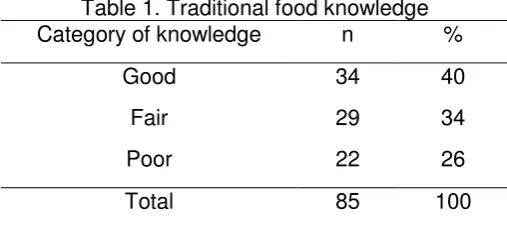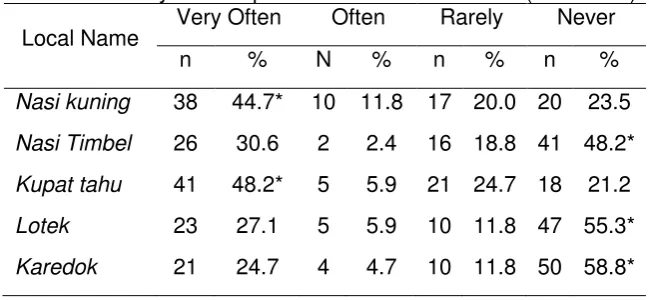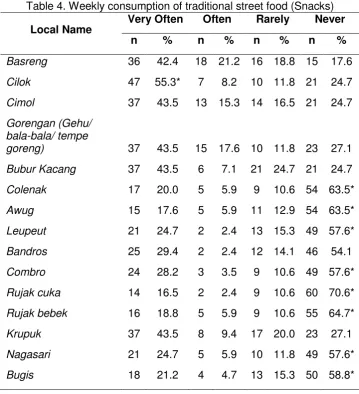Innovation of Vocational Technology Education
Available online at http://ejournal.upi.edu/index.php/invotec
Preliminary Study in Developing Traditional Street Foods as
Nutrition Education Media for Indonesia Youth
Cica Yulia, Elis Endang Nikmawati & Isma Widiaty
Universitas Pendidikan Indonesia, Indonesia
___________________________________________________________________________________________________________________________________
A R T I C L E I N F O A B S T R A C T
1. Introduction
The unceasing of globalization have a devastating impact on the lifestyle of the young generation of Indonesia, including habit to consumed fast. It is happened because Indonesia changed from agriculture to industrial country. One of the sign that the country change to preindustrial country is decreased cerealia and fruit & vegetable consumption and increased processing and preserved food like fast food (Popkin 2006).
Facts prove that fast food related to the incidence of metabolic syndrome in children and adolescents (Golaleh et al. 2015). In addition to impact on the health, consumption of fast food can also affect learning achievement. The results showed that high fast food consumption influence reading and math scores of children (Tobin 2011). This condition is due to the composition of the food and how to cook food fast food less in accordance with the rules of the principle of balanced nutrition. In general, fast food come from
The unceasing globalization has a great influence on the lifestyle of the young generation of Indonesia, including habit to consumed fast food. Many research proved, fast food was not good for health. Habit of eating fast food in Indonesia increased from day to day, especially in the adolescent. This is very dangerous because not only bad for health, but also threat our culture. In general, the aim of this study was to conduct a preliminary study in order to develop traditional foods as a nutrition education media for adolescent. The study de-sign was cross sectional, the respondents were students in junior high school in Bandung. Sampling Technique done by purposive. There were 85 respondents. The results showed that the respondents' knowledge about traditional street food from Sundanese are divided into three categories. 40% had a good knowledge, 34% had fair knowledge and 26% had a poor knowledge. Perceptions of respondents about the importance of having knowledge about traditional foods is 41.2% consider it important. Perceptions of the media information that can be used to educate traditional food are posters in schools (37.65%), brochures (4.71%), computer programs (34.14%) and program /application in smart phone (23.53%).
abroad such as fried chicken, pizza, hamburgers, and soft drinks. According Khomsan (2004) fast food generally contains calories, fat, sugar and sodium (Na) but low in fiber, vitamin A, ascorbic acid, calcium and folate.
Fast food consumption in adolescents has increased, it can be seen from their visits to fast food restaurants are higher. These conditions give a negative impact on the development of traditional street food. Several studies have shown that some traditional foods contain nutrients that are good for the body's growth and development as well as health benefits. Many traditional foods from Indonesia made from tubers which high in fiber. High fiber intake could decrease visceral fat from adipose tissue (Davis 2009). Other traditional from Indonesia is tempe, it is fermented soybean which contain nutrient and active compound. Active compound in tempe act as antibacterial, antioxidant, antianemia and improving digestion (Astawan 2014).
The habit of eating more fast food than choosing traditional foods likely caused by the perception of adolescents who consider that fast food is more valuable than the traditional food. The high consumption of fast food in adolescents can be caused by a low knowledge about nutrition. Results of research Allo et al (2013) showed that children who had lack knowledge have a tendency to eat more fast food and obese.
Based on existing phenomenon, the revitalization of traditional foods as a media of nutrition education for the younger generation is needed. Generally traditional food is always related to aspects of the culture and beliefs of a society. Noble values of a culture in the form of local wisdom (local genius). Traditional food knowledge can contribute nutrition security. Many traditional foods made from diverse sources which could beneficial for nutritional status (Alonso 2015). The purpose of this study was to: 1) To asses adolescent traditional food knowledge, especially Sundanese traditional street foods; 2) to know adolescent eating habits; 3) to know the nutrition education media.
2. Method
2.1 Design and participants
Study design is a cross sectional survey conducted during April - May 2016 in Bandung, West Java. All of the participants are students, aged 13 -14 years. The student were recruited from UPI Junior High School. They were randomly selected, a total 85 participants were included in this study.
2.2 Traditional food knowledge measurement
Traditional food knowledge were measured by objective test with true false question. There were ten question. Traditional food knowledge categorized in three, good if the knowledge > 80%, fair if the knowledge 60-80% and poor, if the knowledge < 60%.
2.3 Eating habit data collection
Eating habits in this study were habit in eating traditional street food from Sundanese (West Java) and habit in eating junk food. Food frequency questionnaire used in this study to measure the eating habit and categories into four categories. Very often when respondents consumed food with a frequency > 4 times a week. Often when respondents consumed food with frequency 3 times a week. Rare when respondents consumed food with frequency 1-3 times a month. Never if the respondents never consumed the specific food.
2.4 Data analysis
The Statistical Package for Social Sciences (SPSS Inc., Chicago, IL, USA) version 21 was used for data analysis. Categorical variables were expressed as numbers and percentages.
3. Result and Discussion 3.1 Tradition food knowledge
foods occurs when the customer orders the meal which can be consumed where it is purchased or taken away. Street foods and fast foods are low in cost compared with restaurant meals and offer an attractive alternative to home cooked food. In spite of these similarities, street food and fast food enterprises differ in variety, environment, marketing techniques and ownership (Winarno & Allain 2016). According to Widyakarya Nasional Pangan & Gizi (2004), street food can be classified in three category : 1) Snack for example traditional cake ; 2) all kind of portion main dish, for example: fried rice, fried noodle; 3) beverage, for example: traditional beverage, ice cream, fruit juice. Traditional food knowledge of respondent describe in table 1.
Table 1 showed that general traditional food knowledge of the respondents divided in three category, good, fair and poor. 40% respondents had a good traditional food knowledge, 34% respondents had fair traditional food knowledge and 26% had poor traditional food knowledge. Knowledge about traditional food were very important, because many of traditional foods were nutritious and good for health. Study from Inuit tribes from Canada showed traditional food intake as a percent of energy was positively correlated to plasma n-3 fatty acids (Spearman rho = 0.58, p <.001) and inversely correlated to plasma transfats (Spearman rho = -.44; p <.01) as percent of total fatty acids in plasma (Egeland et al 2015).
Traditional food knowledge (TFK) refers to a cultural tradition of sharing food, recipes and cooking skills and techniques and passing down that collective wisdom through generations (Kwik 2008). In this
study, traditional food knowledge were assessed by questionnaire. The question was about respondent’s
knowledge about traditional food and divided in three. There were knowledge about traditional main dish from Sundanese, knowledge about traditional beverage from Sundanese and knowledge about traditional snack from Sundanese.
Figure 1. Percentage of tradition foodeating habit
Table 2. Weekly consumption of tradition street food (Main Dish)
Local Name Very Often Often Rarely Never n % N % n % n %
Nasi kuning 38 44.7* 10 11.8 17 20.0 20 23.5
Nasi Timbel 26 30.6 2 2.4 16 18.8 41 48.2*
Kupat tahu 41 48.2* 5 5.9 21 24.7 18 21.2
Lotek 23 27.1 5 5.9 10 11.8 47 55.3*
Karedok 21 24.7 4 4.7 10 11.8 50 58.8*
Table 2 showed traditional street food consumed by respondents from sundanese tribe. Foods were very often consumed by respondents were nasi kuning (44.7%) and kupat tahu (48.2%). Nasi kuning is steamed yellow rice served with omelet, vegetable and sambal. It was a healthy food because contain complex carbohydrate, protein, fat and also vitamin which good for growth. Kupat tahu is boiled rice (lontong) served with tofu, mung bean sprout and peanut sauce. This food also nutritious because it contain complex carbohydrate, protein, fat and vitamin. In contrast there were three traditional food never consumed by respondents. 58.8% respondents never eat karedok. Karedok is tradition salad from Sundanese. It made from raw vegetables served with peanut sauce and lontong. 55.3% respondents never eat Lotek, this food was made from steamed vegetable served with peanut sauce and lontong. Karedok and Lotek was famous food in Sundanese, although it was famous food the respondents which is junior high school students never eat this. Possibility this occurred because the respondents prefer western fast food. 48.2% respondents never eat nasi timbel, this food is nutritious food consist of steamed rice, fried chicken, fried tempe, steamed vegetable and accompany with sambal. All of food which never consumed by respondents were nutritious food. Based on food composition table from ministry of health Indonesia kupat tahu contain energy 274 kcal it could contribute 10 % for adult’s total energy need in a day.
Table 3. Weekly consumption of traditional street food (Beverage)
Local Name Very Often Often Rarely Never
n % n % n % n %
Es goyobod 23 27.1 5 5.9 10 11.8 46 54.1*
Es cendol 30 35.3 4 4.7 10 11.8 41 48.3*
Es cingcau 28 32.9 4 4.7 11 12.9 42 49.5*
Sakoteng 22 25.9 2 2.4 10 11.8 51 60.0*
Table 4. Weekly consumption of traditional street food (Snacks)
Local Name Very Often Often Rarely Never
n % n % n % n %
Basreng 36 42.4 18 21.2 16 18.8 15 17.6
Cilok 47 55.3* 7 8.2 10 11.8 21 24.7
Cimol 37 43.5 13 15.3 14 16.5 21 24.7
Gorengan (Gehu/ bala-bala/ tempe
goreng) 37 43.5 15 17.6 10 11.8 23 27.1
Bubur Kacang 37 43.5 6 7.1 21 24.7 21 24.7
Colenak 17 20.0 5 5.9 9 10.6 54 63.5*
Awug 15 17.6 5 5.9 11 12.9 54 63.5*
Leupeut 21 24.7 2 2.4 13 15.3 49 57.6*
Bandros 25 29.4 2 2.4 12 14.1 46 54.1
Combro 24 28.2 3 3.5 9 10.6 49 57.6*
Rujak cuka 14 16.5 2 2.4 9 10.6 60 70.6*
Rujak bebek 16 18.8 5 5.9 9 10.6 55 64.7*
Krupuk 37 43.5 8 9.4 17 20.0 23 27.1
Nagasari 21 24.7 5 5.9 10 11.8 49 57.6*
Bugis 18 21.2 4 4.7 13 15.3 50 58.8*
Table 4 showed highest percentage in very often consumed snacks is Cilok (55.3%). Cilok is a salty snacks made from tapioca flour similar with meat ball and served with peanut sauce or chili sauce. Nutrient contain in cilok is carbohydrate and protein. Many of traditional snacks never consumed by the respondents. The highest percentage is rujak cuka 70.6%, other snacks were colenak 63.5%, awug 63.5%,
rujak bebek 64.7%, bugis 58.8%, nagasari 57.6%, combro 57.6%, leupeut 57.6%. Rujak cuka is made from tropical fruits and cabbage served with sour sauce from tamarind, palm sugar and chili.
Table 5. Weekly consumption of modern or fast food and beverage
Name of food Very Often Often Rarely Never
n % n % n % n %
More than half respondent very often consumed fast food. Crepes is the highest percentage 57.6%. Other foods were chocolate 56.5%, hotdog 51.8%, candy and snacks 54.1%. Lowest percentage found in never consumed fast food. Generally respondent eat fast food. High fast food consumption can lead overweight and obesity. Study from adolescent in India showed the average fast food intake, screen time and limited outdoor activities were significantly associated with obesity (Kar & Khandelwal 2015).
3.2 Perceptions about the importance of traditional food knowledge as an alternative nutrition education media
Respondent perception about the important of traditional knowledge in this study were 41.2 % said that
it is very important to have traditional food knowledge, and 58.8 % said they don’t know it is important or
not. Traditional food knowledge was very important for all generation. Not only for adult but also for young people, because it can make someone have the capacity in to prepare meals that are nutritious, safe and culturally relevant (Kwik 2008). Respondent said, the place where traditional knowledge can be share was in school 30.6%, in their home 15.3%, both school and home 11.8% and 11.8% said that traditional food knowledge every place is the place to share traditional food knowledge. To deliver traditional food knowledge it will need media so it will easy to understand. Respondents said, traditional food knowledge could be obtained from poster in school 37.6%, leaflet 4.71%, program in computer 34.1% and application in smart phone 23.5%.
4. Conclusion
Less than half respondents had a good knowledge of traditional food but there were still respondents who have a poor knowledge. Respondent rarely eat traditional food. Inverted with traditional eating habits, respondents consume more junk food. Half of the respondents have the perception that the knowledge of traditional food is very important to be owned and media that can be used to deliver materials on traditional foods is program on computer and applications on smartphones.
References
Allo, Barre Aminuddin Syam & Devintha Virani. 2013. The relation between knowledge and habit of
consumption of fast food with occurence of overweight in Sd Negeri Sudirman I Makassar.
repository.unhas.ac.id/bitstream/handle/.../5547/JURNAL.pdf?
Alonso, E.B. 2015. The impact of culture, religion and traditional knowledge on food and nutrition security in
developing countries. FOODSECURE Working paper no. 30 March 2015
Arkarapanthu, Apasara & Visith, C. 2005. Gel extracted from Khrueamanoi (Cyclea barbata Miers) leaves: Chemical composition and gelation properties. Journal of the Science of Food and Agriculture 85:1741– 1749.
Astawan, M. 2014. Kajian Khasiat Berbagai Pangan Lokal sebagai Pangan Fungsional dalam Pencegahan Penyakit Degeneratif dan Peningkatan Kesehatan. https://dl.dropboxusercontent.com/u/34645682/release/ semnas_fikkes/Pangan%20Lokal%20Fungsional%20%28Made%20Astawan%29.pdf
Bargiota, A. 2013. Eating habits and factors affecting food choice of adolescents living in rural areas. 12(2): 246-53.
Davis, J.N. et al. 2009. Inverse relation between dietary fiber intake and visceral adiposity in overweight Latino youth. Am J Clin Nutr 90:1160–1166.
Golaleh Asghari, Emad Yuzbashian, Parvin Mirmiran, Behnaz Mahmoodi,Fereidoun Azizi. 2015. Fast Food Intake Increases the Incidence of Metabolic Syndrome in Children and Adolescents: Tehran Lipid and
Glucose Study. PLOS ONE DOI:10.1371/journal.pone.0139641 October 8, 2015
Kar. Sumit & Bidita Khandelwa. 2015. Fast foods and physical inactivity are risk factors for obesity and hypertension among adolescent school children in east district of Sikkim, India. Journal of Natural Science, Biology and Medicine 6(2).
Khomsan, A. 2004. Pengantar Pangan dan Gizi. Cetakan 1, Penerbit Penebar Swadaya: Jakarta.
Kwik. Jessica Christine. 2008. Traditional Food Knowledge: Renewing Culture and Restoring Health. Thesis. Waterloo, Ontario, Canada.
LIPI. 2004. Prosiding Widyakarya Nasional Pangan dan Gizi VIII, 17-19 Mei 2004.
Popkin, B. 2006. What is the NutritionTransition?.
Tobin, K.J. 2011. Fast food consumption and educational test scores in the USA. Child: care, health and development.
Van Esterik, P. 1999. Gender and sustainable food systems: a feminist critique. For hunger proof cities. M. Koc, McRae, R., Mougeot, L. & Welsh, J. Ottawa, International Development Research Centre.


